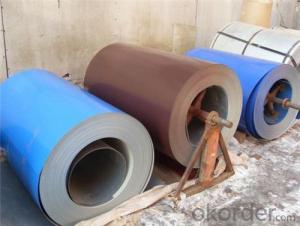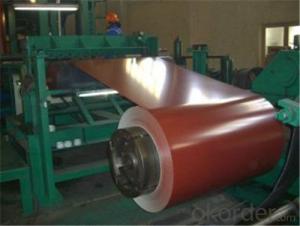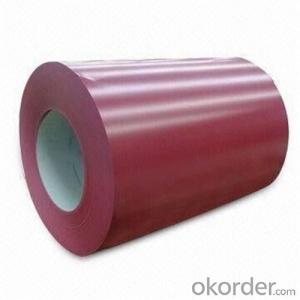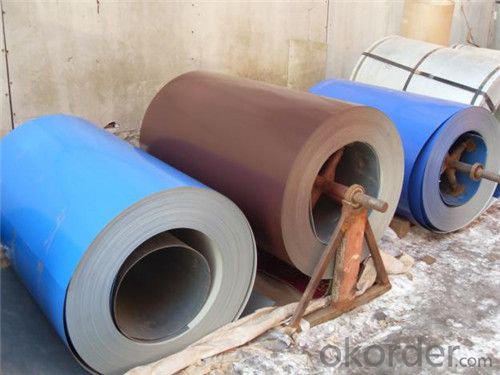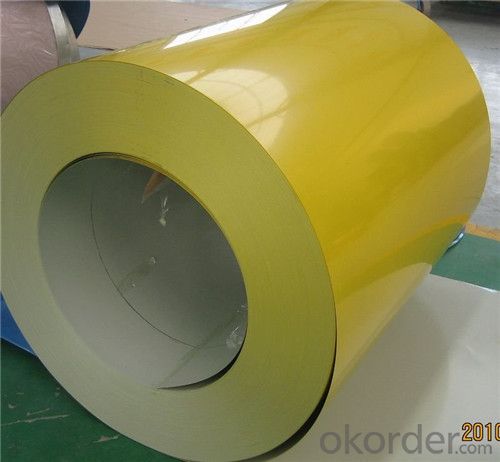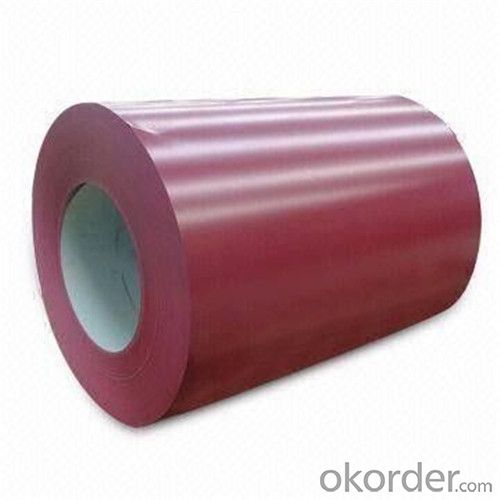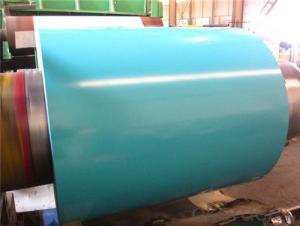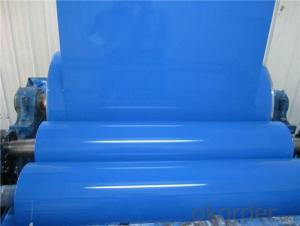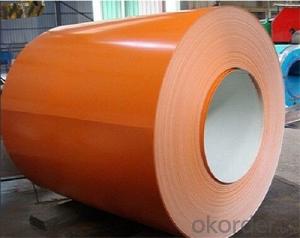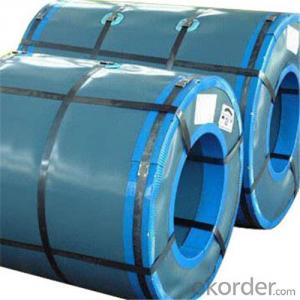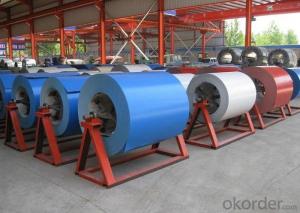Prepainted Rolled Steel Coil For Construction Roofing constrution
- Loading Port:
- Shanghai
- Payment Terms:
- TT OR LC
- Min Order Qty:
- 50 m.t.
- Supply Capability:
- 30000 m.t./month
OKorder Service Pledge
OKorder Financial Service
You Might Also Like
Structure of Prepainted Rolled steel Coil for Construction Roofing

Description of Prepainted Rolled steel Coil for Construction Roofing
Prepainted Rolled steel Coil is a kind of coated steel coil/sheet. With the cold rolled steel of different strength and thickness as substrate, it is produced through applying Al-Zn coat on both faces by hot dip process. In its coating, Al accounts for about 55%, Si 1.6%, while the remaining is Zn. Aluminum zinc coils enjoys both the physical protective feature and durability of Al and the electrochemical protective property of Zn. And its surface has bright silver color and regular embossed-like figure, which are highly decorative.


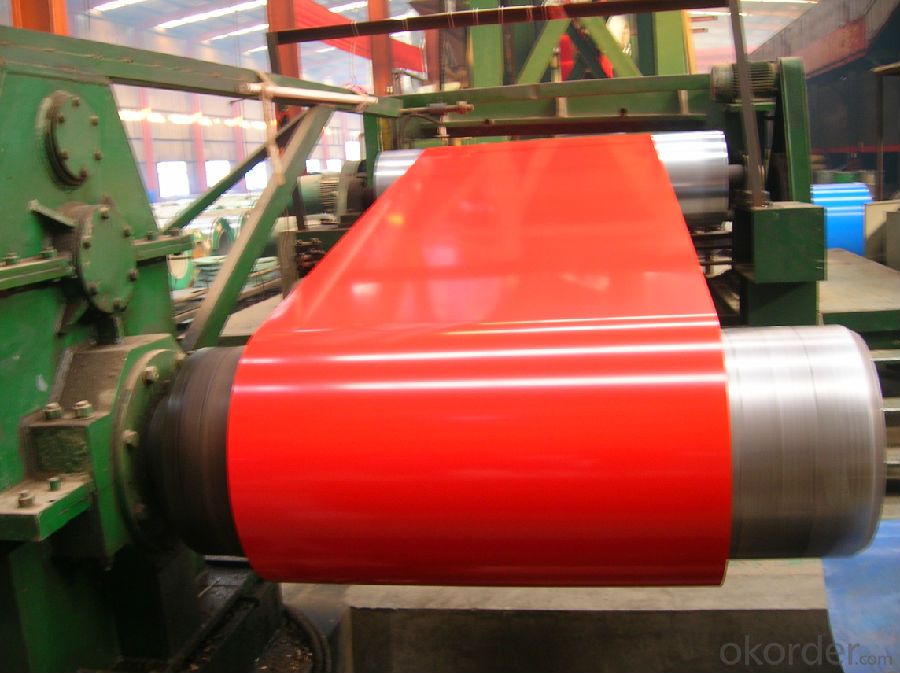
Main Feature of Prepainted Rolled steel Coil for Construction Roofing
1.Corrosion resistance: It mainly depends on the aluminum protection. When the zinc being worn, the aluminum will form a dense layer of aluminum oxide, resist corrosion material to prevent further corrosion inside.
2. Heat resistance: Aluminum zinc alloy steel sheet has excellent heat resistance, can withstand high temperatures over 300 centigrade, and is similar with aluminized steel high temperature oxidation resistance. It often used in chimney pipes, ovens, fluorescent lighting device and the device cover.
3. Heat reflective: Galvanized steel plate heat-reflective high rate is twice as galvanized steel, often used to make insulation materials.
4. Economy: Because density of 55% AL-Zn is smaller than the density of Zn, so in the same weight and thickness of Galvanized zinc layer, aluminum-zinc steel plate is larger area more than 3% of galvanized steel sheet.
Applications of Prepainted Rolled steel Coil for Construction Roofing
1. Construction and building: roofing; ventilating duct; handrail; partition panel;etc.
2. Electric appliance: refrigerator; washing machine; refrigerator; DVD;etc.
3.Transportation: oil tank; road sign; etc.
4.Agriculture:barn; etc.
5.Others:vending machine; game machine; etc.
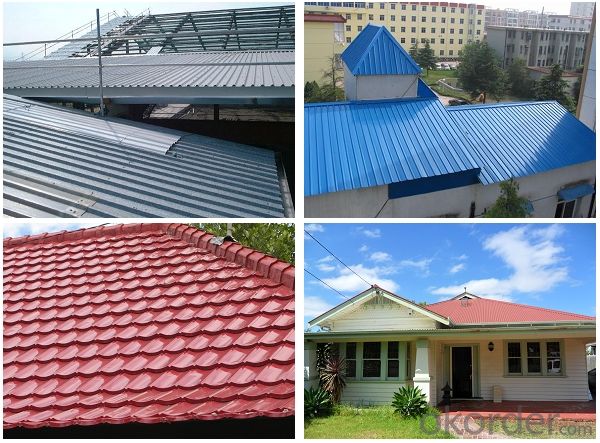
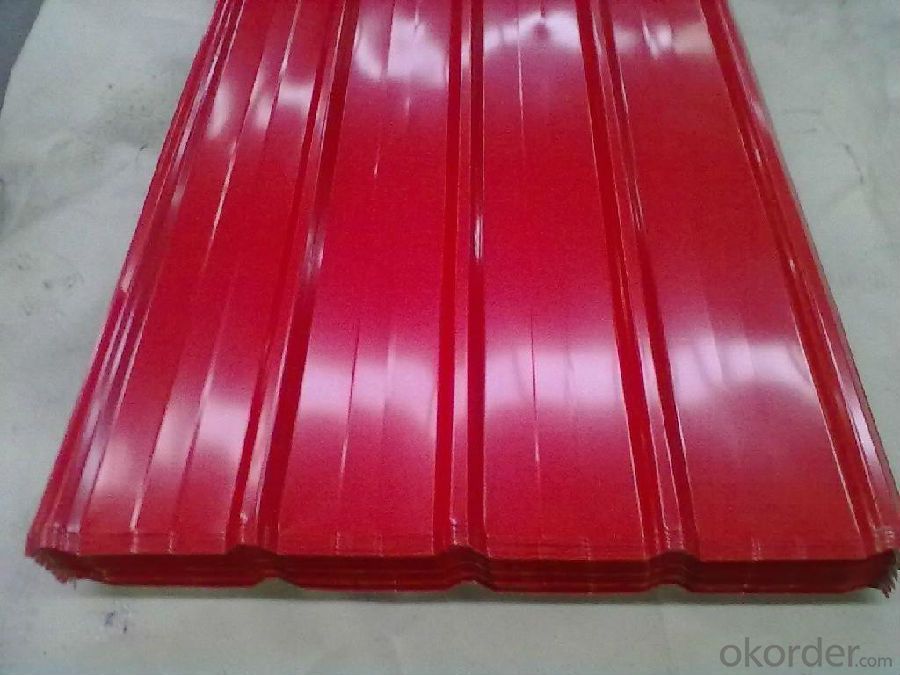
Specifications of Rolled steel Coil for Construction Roofing
Product | Prepainted Rolled steel Coil for Construction Roofing |
Material Grade | SGCC / SGCH / DX51D+AZ, etc |
Thickness | 0.2-3.0mm |
Width | 600-1500mm |
Tolerance | Thickness: +/-0.02mm , Width:+/-2mm |
Zinc-coating | AZ40-150g/m2 |
Technique | Raw material: Hot rolled steel coil --> Cold rolled_>hot dipped galvalume |
Surface | Dried, Chromated, Unoiled |
Spangle | Regular spangle , small spangle, zero spangle |
ID | 508MM |
Coil weight | 10MT max |
Export package | Cardboard inner sleeves, Waterproof paper, galvanized steel covered and steel strip packed |
FAQ of Prepainted Rolled steel Coil for Construction Roofing
We have organized several common questions for our clients,may help you sincerely:
1. What is the minimum order quantity ?
Our MOQ is 50mt for each size. And we will consider to give more discount if you make big order like 1000 tons and more. Further more, the more appropriate payment term your offer the better price we can provide.
2. How long can we receive the product after purchase?
Usually within thirty working days after receiving buyer’s advance payment or LC. We will arrange the factory manufacturing as soon as possible. The cargo readiness usually takes 15-25 days, but the shipment will depend on the vessel situation.
3. How to guarantee the quality of the products?
We have established the international advanced quality management system,every link from raw material to final product we have strict quality test;We resolutely put an end to unqualified products flowing into the market. At the same time, we will provide necessary follow-up service assurance.
- Q: How are steel coils inspected for uniformity using statistical analysis?
- Various techniques and procedures can be employed to inspect steel coils for uniformity using statistical analysis. The primary goal is to guarantee that the coils meet the required specifications and exhibit consistent quality throughout. One prevalent inspection method involves obtaining a representative sample of steel coils from a batch or production run. These coils are selected randomly to ensure a fair representation of the entire batch. Statistical analysis is then conducted on this sample to assess the uniformity of the coils. The initial step entails measuring various physical properties of the coils, such as thickness, width, weight, and surface defects. These measurements are recorded for each coil in the sample. The collected data is subsequently subjected to statistical analysis, encompassing mean, standard deviation, and range calculations. By calculating the mean values of the measured properties, one can determine the average values for thickness, width, weight, etc. These mean values can be compared to the desired specifications to identify any deviations or inconsistencies. The standard deviation serves as an indicator of the variability or dispersion of the data, revealing the degree to which the coils adhere to the desired specifications. A smaller standard deviation denotes greater uniformity. Furthermore, range calculations can be executed to ascertain the difference between the maximum and minimum values of the measured properties within the sample. A smaller range implies a higher level of uniformity. Statistical analysis can also incorporate the use of control charts, such as X-bar and R-charts, to visually track the variation in the measured properties over time. These charts offer a graphical representation of the data, facilitating the identification of any trends or out-of-control conditions. In summary, statistical analysis provides a systematic approach to evaluating the uniformity of steel coils by providing objective measurements and statistical indicators. By analyzing the collected data, manufacturers can detect any deviations from the desired specifications and implement appropriate corrective measures to ensure consistent quality throughout the production process.
- Q: Can you recycle steel? And if you wanted to buy some recycled steel, where would you get it?
- Yes; steel can be recycled. Look on the Internet for dealers who sale recycled steel. Good luck! Smile!
- Q: What are the different types of steel coil treatments?
- Enhancing the properties and performance of steel coils involves various types of treatments. The treatments include: 1. Heat treatment known as annealing. It involves heating the steel coil to a specific temperature and gradually cooling it. This treatment alleviates internal stresses, enhances ductility, and boosts the overall strength of the coil. 2. Chemical treatment called pickling. It entails submerging the steel coil in an acid or chemical solution to eliminate impurities, scale, and rust from the surface. This treatment enhances the surface finish and cleanliness of the coil. 3. Application of a protective coating such as oil. A thin layer of oil or another protective substance is applied to the surface of the steel coil. This treatment prevents corrosion, improves lubricity, and safeguards the coil during storage and transportation. 4. Galvanizing, a process that involves coating the steel coil with a layer of zinc. This protective layer shields the coil from corrosion, creating a barrier between the steel and the surrounding environment. It ensures long-term durability and resistance to rust. 5. Tempering, a heat treatment process that includes heating the steel coil to a specific temperature and swiftly cooling it. This treatment enhances the toughness and strength of the coil, making it more resistant to impact and deformation. These are just a few instances of the various types of steel coil treatments commonly employed. Each treatment has its own unique purpose and advantages, and the choice of treatment will depend on the desired properties and applications of the coil.
- Q: I'm not really sure if carbon steel is considered a metallic material.
- Carbon and iron are both metallic.... so yes. You leave the iron laying in the forge - and it soaks up carbon atoms from the charcoal - so that as the steeling process goes on, the original iron becomes harder and harder.
- Q: What are the quality standards for steel coil production?
- The quality standards for steel coil production typically include factors such as dimensional accuracy, surface finish, mechanical properties, chemical composition, and adherence to industry-specific standards and specifications. These standards ensure that the steel coils meet the required strength, durability, and performance criteria, and are suitable for various applications in industries like automotive, construction, and manufacturing.
- Q: I believe steel is stronger but it steel lighter than iron too?
- Steel is iron, with other things added that strengthen it and/or make it less rust liable. So, in general, steel is stronger than iron. In so far as the density, that depends on the steel alloy. Some are higher than iron, some lower. Remember there are hundreds of different steel alloys. edit: but the density is still close to that of iron. density steel 7750 to 8050 kg/m? density iron 7870 kg/m?
- Q: What are the different surface treatments available for steel coils?
- There are several different surface treatments available for steel coils, including galvanizing, painting, and powder coating. Galvanizing involves applying a layer of zinc to the surface of the steel to provide corrosion resistance. Painting involves applying a layer of paint to the surface to enhance its appearance and protect it from rusting. Powder coating is a process where dry powder is electrostatically applied to the steel surface and then cured under heat to form a protective and decorative coating.
- Q: How do steel coils contribute to energy efficiency in lighting?
- The energy efficiency of lighting relies heavily on the type of light source chosen, such as incandescent, fluorescent, LED, or halogen bulbs. Each of these light sources consumes energy differently. On the other hand, steel coils serve a different purpose in lighting fixtures. Their main function is to provide structural support, dissipate heat, and protect the components. They do not have a direct impact on the energy efficiency of the lighting system. However, steel coils can indirectly improve energy efficiency by offering sturdy support to the fixtures. This ensures that the installations are reliable and long-lasting, reducing the need for frequent maintenance and replacements. A well-supported lighting system guarantees optimal performance and minimizes energy wastage or inefficiencies caused by loose or unstable fixtures. Furthermore, steel coils can also be used to manufacture reflectors or housings for lighting fixtures. These components play a role in enhancing the overall efficiency and distribution of light. By effectively reflecting and directing the light output, energy utilization and illumination can be optimized, resulting in reduced energy waste. Although steel coils themselves do not directly influence the energy efficiency of lighting, their incorporation in the construction and support of lighting fixtures indirectly contributes to a more energy-efficient lighting system.
- Q: I want to purchase a set of knives made of carbon steel and want to be able to store them on a magnetic knife strip for handy access, I just wasn't sure if this alloy would stick to a magnet????Thanks
- Yes, carbon steels are magnetic. In fact, some stainless steel knives are magnetic as well. Some stainless steel alloys are naturally magnetic and some become magnetic when they are deformed by forging or rolling (check out a deep drawn SS sink and explore where it is magnetic and where it isn't). Depending on the details, some carbon steels can be made harder than the stainless steel typically used for knives (440 alloy) but the carbon steel knives are very much more likely to suffer corrosion. hope this helps
- Q: I have a knife with 154cm steel on it and I always here that you should put oil on it to keep it from rusting but I am just wondering what kind of oil? And how do I apply it and do I just leave it on there?
- It's stainless steel so it doesn't really need to be oiled. Anything will do for oil if you want to wipe it down. Just put a little on a paper towel and give it a once-over.
Send your message to us
Prepainted Rolled Steel Coil For Construction Roofing constrution
- Loading Port:
- Shanghai
- Payment Terms:
- TT OR LC
- Min Order Qty:
- 50 m.t.
- Supply Capability:
- 30000 m.t./month
OKorder Service Pledge
OKorder Financial Service
Similar products
Hot products
Hot Searches
Related keywords
